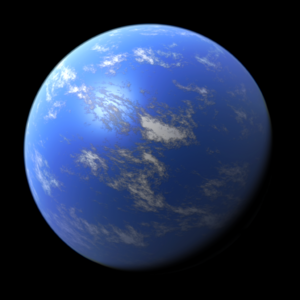Hycean world
A Hycean world is a proposed type of habitable world, first described in September 2021, in a paper published in The Astrophysical Journal.[1][2]
These worlds, if they exist, would be larger than planet Earth, and smaller than planet Neptune.[1] They would have a thick ocean, where life might be found, covered by a thich Hydrogen atmosphere.
The habitable zone for a hycean world would be broader than that for a terrestrial habitable planet.[1]
As astronomer have hunted for exoplanets that could harbour life, the suitability of earth-sized planets orbiting small red dwarf stars has stirred debate. Red dwarfs stars, while generally dimmer than Earth's sun Sol, are prone to occasional massive stellar flares, flares so large they would strip earth-sized planets of their atmospheres. This concern would not affect ocean life on a water world.[1]
In addition, due to the smaller mass of red dwarf stars, their planets are likely to be tidally locked to the star, because they would orbit much more closely. A hycean world tidally locked to a red dwarf, that was too close to its star for life on its surface, could have a ring of ocean at a temperature that could sustain life on its night side.[1]
The authors of the paper, Nikku Madhusudhan, Anjali A. A. Piette and Savvas Constantinou, all of the University of Cambridge, prepared a list of candidates that might be candidates for life bearing hycean worlds.[1] [3] They stated that the James Webb Space Telescope was capable of measuring biosignatures that, if found on these worlds, would suggest they had oceans harbouring life.[3]
Spaceflight Insider reported some scientists believe that the biosignatures indicative of life on these planets might be found "within the next two to three years".[1] The Guardian, however, quoted Beth Biller, of the Max-Planck Institute for Astronomy, who, while she welcomed using the James Webb telescope to study hycean world candidates, noted that, since we already know planet Earth harbours life, we have confidence of what gases found in an Earth-like exoplanet would indicate life, we can't have that kind of confidence of the significance of the gases detected in mini-Neptune planets.[2]
The Cambridge Independent reported Madhusudhan's team developed its model for hycean planets while studying the exoplanet K2-18b.[4]
According to The Guardian biosignatures would be more easily detected in the atmospheres of mini-Neptune sized planets, compared with smaller terrestrial planets, like planet Earth, due to their thicker atmospheres.[2]
References
- ↑ 1.0 1.1 1.2 1.3 1.4 1.5 1.6 Laurel Kornfeld. New class of exoplanets identified in search for extraterrestrial life, Spaceflight Insider, 2021-09-05. Retrieved on 2022-02-13. “Not present in our own solar system, these worlds are known as Hycean planets. They are typically up to 2.5 times larger than Earth, covered mostly or completely by oceans of liquid water, and have hydrogen-rich atmospheres.”
- ↑ 2.0 2.1 2.2 Nicola Davis. ‘Mini-Neptunes’ beyond solar system may soon yield signs of life, The Guardian, 2021-08-26. Retrieved on 2022-02-13. “But University of Cambridge astronomers believe there may be more promising possibilities after recent work suggested that a “mini-Neptune” more than twice the radius of Earth and more than eight times as massive may also be habitable.”
- ↑ 3.0 3.1 (2021-08-26) "Habitability and Biosignatures of Hycean Worlds". DOI:https://doi.org/10.3847/1538-4357/abfd9c. Retrieved on 2022-02-13. Research Blogging.
- ↑ Paul Brackley. Hycean planets: Cambridge astronomers say our best hope for finding extraterrestrial life may have been hiding in plain sight, The Cambridge Independent, 2021-09-02. Retrieved on 2022-02-13. “Their discovery came when Dr Madhusudhan’s team at the Institute of Astronomy studied a mini-Neptune called K2-18b.”
